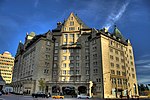Low Level Bridge

The Low Level Bridge is a bridge that spans the North Saskatchewan River in Edmonton, Alberta, Canada. Completed in 1900, this was the first bridge across the North Saskatchewan River. It was designed to carry a railway, and a railway track was added in 1902 to accommodate the Edmonton, Yukon and Pacific Railway (amalgamated with the Canadian Northern Railway in 1905).Streetcars used the bridge (on a gauntlet track) from 1908 to 1939. Trolley buses used the bridge from the removal of the streetcar track in 1939 until 1965.Originally known simply as the Edmonton Bridge or the Inter-Urban Bridge (connecting the towns of Strathcona and Edmonton), the bridge became known as the Low Level Bridge some time after the completion of the High Level Bridge. In 1948 a twin span of the same design was added upstream of the original span. The new span was originally used for vehicle traffic in both directions, with the original span being reserved for railway use. When the railway track was removed from the original span in 1954, that bridge was widened and then used for two lanes of west-bound traffic. The 1948 bridge has carried all east-bound traffic since the widening of the original span.The Low Level Bridge connects the communities of Cloverdale on the south end to Rossdale/Downtown on the north end.
Excerpt from the Wikipedia article Low Level Bridge (License: CC BY-SA 3.0, Authors, Images).Low Level Bridge
Connors Road NW, Edmonton Greater Strathcona
Geographical coordinates (GPS) Address Nearby Places Show on map
Geographical coordinates (GPS)
| Latitude | Longitude |
|---|---|
| N 53.538055555556 ° | E -113.48694444444 ° |
Address
Low Level Bridge
Connors Road NW
T5J 2E7 Edmonton, Greater Strathcona
Alberta, Canada
Open on Google Maps









